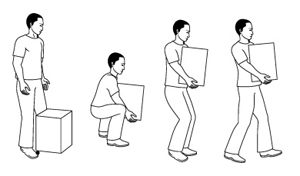Tips for Safer Lifting
Incorrect lifting method is often a primary cause of back strain and injury. A back
injury caused by lifting may result in these problems:
-
Muscle injury. Stress on the lower back muscles can happen when you get out of correct position
while lifting. Too much stress on the muscles can cause strain, pull, or small tears.
-
Disk injury. A disk is a type of cushion between the bones of the spine. A back injury can cause
a disk to bulge or rupture and then press on nearby nerves to cause pain and discomfort.
-
Joint injury. This type of injury can happen when you use incorrect lifting methods, even when the
item you're lifting is relatively light.

These tips can help prevent injury when lifting objects:
-
Face the object you want to lift and, with your back straight, move your whole body
to protect your back. Bend your knees and hips, not your back. Don't bend or lift
if you are off balance or if your back is twisted. If needed, bend one knee to kneel
down, with the other foot flat on the floor.
-
Tilt the object to one side, if possible, so it can be lifted from underneath.
-
Keep the object close to your body.
-
Support your back by tightening and holding in your belly muscles.
-
Use your arms, legs, and buttocks to lift the object. Lift with your legs, not your
back. Don't twist.
-
Keep a firm grip on the load, and keep your arms and elbows close to the body while
lifting.
When carrying the load, keep it close to your body. Don't twist your back. Keep your
shoulders and hips in line with each other. When changing direction, shift the position
of your feet and turn your entire body.
When you're ready to set the load down, bend your knees to lower it rather than bending
at the waist. If the object is to be placed on a shelf, bench, or table, set it on
the edge of the shelf (or bench or table) and push it into the desired position.
Remember, it's better to ask for help to lift a heavy object than to injure your back.